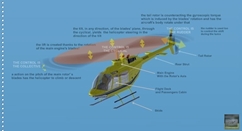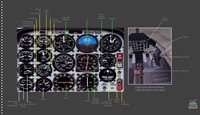 .home page .back Tutorials. Helicopters
.home page .back Tutorials. Helicopters
| Important! To Read! this tutorial, like those about the night VFR and IFR ratings, and about flying the airliners is not as accurate and reliable than those dedicated to the VFR flights. It's because we really practised the VFR flights, as we didn't ever qualify for the night VFR and the IFR ratings nor any commercial license! Our tutorials about such flights are based on our VFR experience only, and augmented with data and readings taken from the Internet! People who would like to find in those the same level of accuracy and details than in our VFR tutorials, should better turn to further websites or source. People who are just looking for a honest level of realism might be satisfied already with the level of our tutorials about the night VFR, IFR flights, the ones aboard an airliner, and the helicopters |
 | click on the picture to a view of the major components of a helicopter, why a helicopter flies and what the controls the fly are |
A helicopter doesn't fly like a plane, as he doesn't feature any wings. With a helicopter, the fact that it is flying is due to the main engine's blades rotating. The pales rotating atop the helicopter are yielding a plane. It's that plane which constitutes, as a whole, the 'wing' of the helicopter. The blades rotating are creating the lift for a helicopter, like the wings are for a plane. The rotation of the main blades of the helicopter, on the other hand, is generating a gyroscopic torque. The result if that the helicopter's body, below the blades plane, is rotating by itself; to counteract the torque, helicopters are equipped with a tail rotor, which balances the tendency. The tail rotor however is derivating some power from the main engine. The whole of the main blades rotating plane further is inclinable in every direction, on 360 degrees. All those features -a lift providing by the plane of the rotating blades and the whole plane of the blades which can be changed in inclination- are allowing the helicopter to fly. Here is how! First, an action on the pitch of the two main blades of the main rotor is allowed, which have the helicopter to climb or to descent as this allows to take more or less profit from the engine's power. The inclination then of the whole of the blades rotating -up or down, left or right- allows so steer the helicopter in every direction. When the pilot pushes the plane of the main engin rotor blades down or up, the helicopter climbs, or descent. When he pushes the plane left or right, the helicopter turns! On a modern helicopter, there is not any throttle control with the rotation speed of the main engine being controlled by a mechanism adjusting automatically the rotation speed function of the pitch of the blades set by the pilot. On the former helicopters, one independent throttle control was extant. A helicopter, at last, is featuring a rudder, as it's controling the tail rotor. The action is to correct for the gyroscopic torque induced by the change of the blades' pitch and too for the slip the helicopter endures, like any usual plane, when engaged into a turn (the action on the rudder makes that the turn is, like for a plane, coordinated, with the nose of the helicopter not shifting away, or inside, the turn, due to the drag). No trim controls either are found on a helicopter. When some, there is only one, which acts upon the whole of the rotating blades' plane. A helicopter, at last, does not feature any flaps!
How does one, in terms of flying, operate all that dynamics of a helicopter? The first remarkable feat is that the pilot is seated right, unlike in a plane, where he is seating left. This is likely due to the fact that acting upon the blades' pitch control is made with the left hand and that the -more natural- action upon the heading control is made, through a stick, with the right hand. Three main actions are required from the pilot of a helicopter. The one upon the pitch of the main blades, the inclination of the whole of the rotating blades, and an action upon the tail rotor. The pilot thus is using three main controls. The 'collective', the 'cyclical', and the rudder. The action upon the controls must be soft, much softer than with a plane, and more still than with a plane, any action upon a control is usually necessitating an action upon the other controls!
Generally speaking, the reference used for this tutorial stress the fact that the pilotage of a helicopter is a much delicate thing. To the point, for example, that the simple fact to look into the direction which one wants to have the aircraft to turn into, will have it actually turn!
A helicopter's panel, of course, is featuring the gauges, values, and commands which are specific to that type of aircraft as it features too gauges and command which you will have already seen or used aboard a plane
 | click on the picture to a view of a helicopter's panel in details, with a general view of the flight deck |
The FS2002 Bell 206B JetRanger III's engine is a turbine. That means that the helicopter is powered, strictly, through a engin which is similar to the one of a airliner. The power of the engine however, in the case of a helicopter, is transmitted to the main, and tail rotors! A turbine engine works like turbines, which are looking like ventilators, are several sets of winglets, the axis of which is the main axis of the engine, and which are setteled ahead of the engine. Such turbines are accelerating air into, eventually, a combustion chamber which is located behind the turbines. Along its way, further, the air is compressed. Once it got at the combustion chamber, the air mixes with fuel and ignites! That yields hot, exhaust gas. Those gas, for a plane, are giving the thrust. In a helicopter that power is used to propell both the aircraft's rotors. As it is a turbine powered aircraft, the Bell 206B JetRanger III's engine thus needs that the panel takes in account the specifics of that type of engine. Like what is seen for a jetliner, for example, you'll find on the panel of a helicopter the 'low pressure compression rpm in percentage', which is just the famed N1! Specific also of a turbine engine are the N2 (high pressure compression rpm in percentage) -which for the helicopter is coupled to the rotor rpm- the exhaust gas temperatures, or EGT, the oil pressure and temperature, and the fuel flow gauges. Like for aboard a jetliner, such values are controlled through the gas throttle input only. As, as far a helicopter like the Bell 206B is concerned, the gas throttle action is in fact self-regulated when any input is exerted upon the collective, you, like a pilot, will not have to overcheck those gauges! Just has them checked intermittently to monitor whether they are resting with their required values. For the helicopters, at the contrary, which would need the pilot's action upon the gas throttle, the pilot will have to have such a input made (the CTRL+F1 to F4 in FS2002 for example), and to check the corresponding gauges, like with a airliner, for example. At last, due to how a helicopter is working, the following gauges are specific too to a helicopter, like the tranmission oil pressure and temperature -which is the oil system used for the mechanical actuators which are linking the collective control inputs towards the main rotor blades' pitch, or the torque. The torque is determined by the action throught the collective as the blades' pitch increase increases the gyroscopic effect of the rotor too (which makes that the aircraft's body is rotating in the opposite direction to the rotor, under the rotor, which is rightwards for the Bell 206B. That torque is displayed in a percentage of the torque as any step of a flight with a helicopter may be matched with such or such value for the torque
As far as for the remaining of the gauges is concerned, like the airspeed indicator, the AI, the altimeter or such, they are mostly similar in their aspect and use to those of a plane. And the same for the radionavigation aids or the radio panel. One of the main differences compared to a plane is lying too in the fact that the pilot, in a helicopter is seated to the right of the flight deck as left in a plane
Website Manager: G. Guichard, site Lessons In Microsoft Flight Simulator / Leçons de vol pour les Flight Simulator de Microsoft, http://flightlessons.6te.net.htm. Page Editor: G. Guichard. last edited: 5/27/2013. contact us at ggwebsites@outlook.com